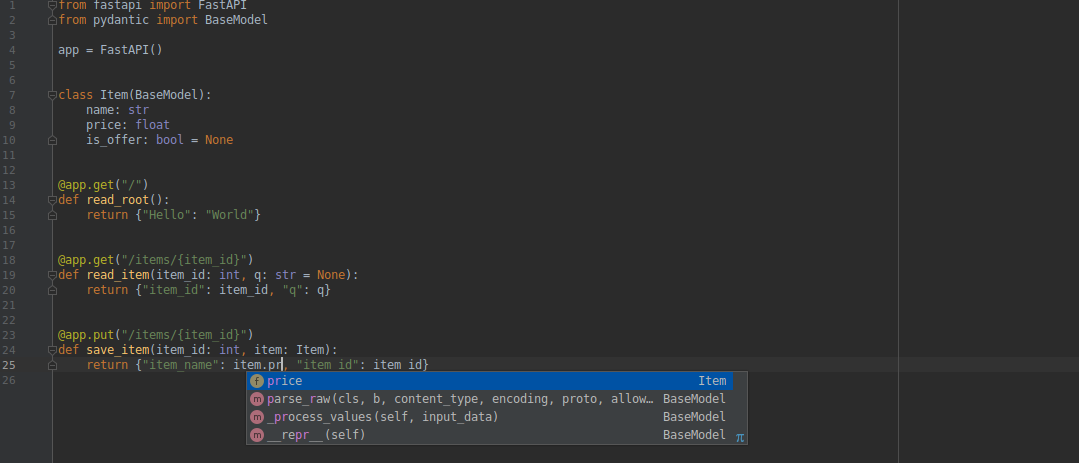- Sort Score
- Result 10 results
- Languages All
Results 31 - 40 of 957 for bike (0.46 sec)
-
docs/tr/docs/features.md
 Daha önceden düşünüp en imkansız diyebileceğin durumlarda bile otomatik tamamlama alacaksın, örnek olarak `price` JSON body içerisinde (nested bir JSON body de olabilirdi.) direkt olarak istekten geliyor, bu durumda bile oto-tammalama sağlıyor.
Registered: Sun Dec 28 07:19:09 UTC 2025 - Last Modified: Sat Oct 11 17:48:49 UTC 2025 - 11.1K bytes - Viewed (0) -
docs/en/docs/advanced/custom-response.md
#### Using `StreamingResponse` with file-like objects { #using-streamingresponse-with-file-like-objects } If you have a <a href="https://docs.python.org/3/glossary.html#term-file-like-object" class="external-link" target="_blank">file-like</a> object (e.g. the object returned by `open()`), you can create a generator function to iterate over that file-like object.Registered: Sun Dec 28 07:19:09 UTC 2025 - Last Modified: Wed Dec 17 20:41:43 UTC 2025 - 12.4K bytes - Viewed (0) -
docs/en/docs/benchmarks.md
Registered: Sun Dec 28 07:19:09 UTC 2025 - Last Modified: Sun Aug 31 09:15:41 UTC 2025 - 3.5K bytes - Viewed (0) -
docs/pt/docs/tutorial/request-files.md
* Ele expõe um objeto python <a href="https://docs.python.org/3/library/tempfile.html#tempfile.SpooledTemporaryFile" class="external-link" target="_blank">`SpooledTemporaryFile`</a> que você pode passar diretamente para outras bibliotecas que esperam um objeto semelhante a um arquivo("file-like"). ### `UploadFile` { #uploadfile }
Registered: Sun Dec 28 07:19:09 UTC 2025 - Last Modified: Wed Nov 12 16:23:57 UTC 2025 - 8.1K bytes - Viewed (0) -
docs/en/docs/how-to/conditional-openapi.md
<div class="termy"> ```console $ OPENAPI_URL= uvicorn main:app <span style="color: green;">INFO</span>: Uvicorn running on http://127.0.0.1:8000 (Press CTRL+C to quit) ``` </div> Then if you go to the URLs at `/openapi.json`, `/docs`, or `/redoc` you will just get a `404 Not Found` error like: ```JSON { "detail": "Not Found" }
Registered: Sun Dec 28 07:19:09 UTC 2025 - Last Modified: Wed Dec 17 20:41:43 UTC 2025 - 2.4K bytes - Viewed (0) -
docs/zh/docs/tutorial/request-files.md
* 可获取上传文件的元数据; * 自带 <a href="https://docs.python.org/zh-cn/3/glossary.html#term-file-like-object" class="external-link" target="_blank">file-like</a> `async` 接口; * 暴露的 Python <a href="https://docs.python.org/zh-cn/3/library/tempfile.html#tempfile.SpooledTemporaryFile" class="external-link" target="_blank">`SpooledTemporaryFile`</a> 对象,可直接传递给其他预期「file-like」对象的库。 ### `UploadFile` `UploadFile` 的属性如下:
Registered: Sun Dec 28 07:19:09 UTC 2025 - Last Modified: Mon Nov 18 02:25:44 UTC 2024 - 6.3K bytes - Viewed (0) -
android/guava/src/com/google/common/base/Converter.java
* * 2. The supertype of this class could be `Function<@Nullable A, @Nullable B>`, since * Converter.apply (like Converter.convert) is capable of accepting null inputs. However, a * supertype of `Function<A, B>` turns out to be massively more useful to callers in practice: They * want their output to be non-null in operations like `stream.map(myConverter)`, and we can
Registered: Fri Dec 26 12:43:10 UTC 2025 - Last Modified: Wed Jun 18 21:43:06 UTC 2025 - 22.8K bytes - Viewed (0) -
docs/en/docs/tutorial/bigger-applications.md
Registered: Sun Dec 28 07:19:09 UTC 2025 - Last Modified: Wed Dec 10 08:55:32 UTC 2025 - 18.6K bytes - Viewed (0) -
docs/en/docs/tutorial/body-multiple-params.md
/// ## Multiple body parameters { #multiple-body-parameters } In the previous example, the *path operations* would expect a JSON body with the attributes of an `Item`, like: ```JSON { "name": "Foo", "description": "The pretender", "price": 42.0, "tax": 3.2 } ``` But you can also declare multiple body parameters, e.g. `item` and `user`:Registered: Sun Dec 28 07:19:09 UTC 2025 - Last Modified: Sat Sep 20 12:58:04 UTC 2025 - 4.9K bytes - Viewed (0) -
docs/features/connections.md
They're also concrete: each URL identifies a specific path (like `/square/okhttp`) and query (like `?q=sharks&lang=en`). Each webserver hosts many URLs. ### [Addresses](https://square.github.io/okhttp/4.x/okhttp/okhttp3/-address/) Addresses specify a webserver (like `github.com`) and all of the **static** configuration necessary to connect to that server: the port number, HTTPS settings, and preferred network protocols (like HTTP/2).
Registered: Fri Dec 26 11:42:13 UTC 2025 - Last Modified: Mon Feb 21 03:33:59 UTC 2022 - 5.4K bytes - Viewed (0)